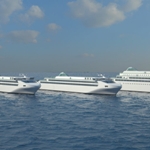Wärtsilä And Deltamarin Introduce Ferry Family
 At the Interferry Conference in New York, Wärtsilä and Deltamarin have announced the introduction of an innovative series of ferry designs. By working in partnership, the two companies have identified the need for a rational approach to ferry design, and to the entire newbuilding process, producing sleek, modern ferry design concepts that incorporate both operational and environmental considerations.
At the Interferry Conference in New York, Wärtsilä and Deltamarin have announced the introduction of an innovative series of ferry designs. By working in partnership, the two companies have identified the need for a rational approach to ferry design, and to the entire newbuilding process, producing sleek, modern ferry design concepts that incorporate both operational and environmental considerations.
Ferries are a niche market and represent less than 1% of the world’s shipping fleet. Most ferries have a unique design, which is produced according to the special characteristics of each route, highly diverse passenger and freight requirements, and the owner’s own business model. This diversity results in very high prototype costs for each vessel, to the extent that ferries may be hard to trade and finance. However, standardisation has seldom been the answer, and has usually led to sub-optimal ships with low profitability.
“The economic viability of advanced technical solutions can only come about through an integrated approach. By combining our companies’ complementary expertise in ship design and integrated technologies, we believe that such viable solutions can be attained”, said Mr Wilco van der Linden, Director Business Development, Cruise & Ferry, Wärtsilä Ship Power. “Deltamarin will provide their vast design expertise in ferries, and in particular the development of advanced, high-performance hull forms for new designs. These complementary capabilities will provide a valuable service to the international Ferry industry”, said Mr Markku Kanerva, Deltamarin’s Sales Director for Contracting Services.
Parametric Design Method
From an environmental point of view, in the future ferries will have to operate using less fuel and creating lower emission levels. This can be achieved by benefiting from state-of-the-art design improvements, through optimizing machinery and systems, and by implementing the latest innovations in propulsion technology. These innovations are costly and must be standardized wherever possible.
The break-through achieved by Wärtsilä and Deltamarin is the development of the so-called Parametric Design Method. Using this method, designers can make a clear distinction between the marketable and non-marketable features of a vessel. For example, the size and architecture of the passenger accommodation and recreation areas are marketable features of a ship, and can be tailored to each customer’s particular needs. On the other hand, the construction of the ship – the engine room layout, piping and ventilation, power, navigation and automation systems can all be designed using a more industrial method. By modularizing and parameterising these elements within the ship, the same benefits can be utilized in subsequent ships without them becoming duplicates.
Operational & Investment Savings
The savings resulting from use of the parametric approach will be considerable, both in the initial investment as well as in operational costs. The industrial engineering of ship systems, and the serial effect created from pre-designed modules, are estimated to result in cost savings of approx. 15%. The fuel economy of these ferries, compared with ferries built 10-15 years ago, will also improve by 15%, not least as a result of developments in Wärtsilä’s technology and Deltamarin’s advances in ship design.
Environmentally Sustainable Strategy
Evolving emission regulations will inevitably require the re-design of many vessel types. This is especially true for ferries operating in (future) ECAs (Emission Control Areas), and having passengers as their most important ‘cargo’. An important aim of this project is to introduce advanced, environmentally sound solutions, applied in a modular way and that are prepared for any future requirements. Deltamarin and Wärtsilä are continuously developing these solutions, and will continue to do so with this aim as a vital element of the sustainability strategy in both companies. Examples of this joint commitment include Deltamarin’s highly efficient ferry designs that are setting new standards in the market, and Wärtsilä’s propulsion arrangements, exhaust gas cleaning systems, and in particular, its base of installed LNG Dual Fuel marine engines, which is the largest in the market.






